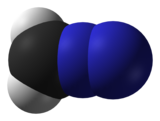Diazomethane

| |

| |
| Names | |
|---|---|
| IUPAC name
Diazomethane
| |
| Other names
Azimethylene,
Azomethylene, | |
| Identifiers | |
3D model (
JSmol ) |
|
| ChEBI | |
| ChemSpider | |
ECHA InfoCard
|
100.005.803 |
| EC Number |
|
| KEGG | |
PubChem CID
|
|
| UNII | |
CompTox Dashboard (EPA)
|
|
| |
| |
| Properties | |
| CH2N2 | |
| Molar mass | 42.04 g/mol |
| Appearance | Yellow gas |
| Odor | musty |
| Density | 1.4 (air=1) |
| Melting point | −145 °C (−229 °F; 128 K) |
| Boiling point | −23 °C (−9 °F; 250 K) |
| hydrolysis[1] | |
| Structure | |
| linear C=N=N | |
| polar | |
| Hazards | |
| Occupational safety and health (OHS/OSH): | |
Main hazards
|
toxic and explosive |
| GHS labelling: | |
 
| |
| Danger | |
| H350 | |
| P201, P202, P281, P308+P313, P405, P501 | |
| NFPA 704 (fire diamond) | |
| Lethal dose or concentration (LD, LC): | |
LC50 (median concentration)
|
175 ppm (cat, 10 min)[3] |
| NIOSH (US health exposure limits): | |
PEL (Permissible)
|
TWA 0.2 ppm (0.4 mg/m3)[2] |
REL (Recommended)
|
TWA 0.2 ppm (0.4 mg/m3)[2] |
IDLH (Immediate danger) |
2 ppm[2] |
| Related compounds | |
Related functional groups;
compounds |
R-N=N=N (azide), R-N=N-R (azo); R2CN2 R = Ph, tms, CF3 |
Except where otherwise noted, data are given for materials in their standard state (at 25 °C [77 °F], 100 kPa).
| |
Diazomethane is an organic chemical compound with the formula CH2N2, discovered by German chemist
Use
For safety and convenience diazomethane is always prepared as needed as a solution in

In more specialized applications, diazomethane and

Diazomethane reacts with
Diazomethane is also frequently used as a
Preparation

Diazomethane is prepared by hydrolysis of an ethereal solution of an N-methyl nitrosamide with aqueous base. The traditional precursor is N-nitroso-N-methylurea, but this compound is itself somewhat unstable, and nowadays compounds such as N-methyl-N'-nitro-N-nitrosoguanidine (MNNG) and N-methyl-N-nitroso-p-toluenesulfonamide (Diazald)[10] are preferred.[11]
CH2N2 reacts with basic solutions of D2O to give the deuterated derivative CD2N2.[12]
The concentration of CH2N2 can be determined in either of two convenient ways. It can be treated with an excess of
Related compounds
Diazomethane is both isomeric and
- The very stable (CF3)2CN2 (2-diazo-1,1,1,3,3,3-hexafluoropropane; b.p. 12–13 °C),[13]
- Ph2CN2 (diazodiphenylmethane; m.p. 29–30 °C).[14]
- (CH3)3SiCHN2 (trimethylsilyldiazomethane), which is commercially available as a solution and is as effective as CH2N2 for methylation.[15]
- PhC(H)N2, a red liquid b.p.< 25 °C at 0.1 mm Hg.[16]
Safety
Diazomethane is toxic by inhalation or by contact with the skin or eyes (TLV 0.2 ppm). Symptoms include chest discomfort, headache, weakness and, in severe cases, collapse.
CH2N2 may explode in contact with sharp edges, such as ground-glass joints, even scratches in glassware.[19] Glassware should be inspected before use and preparation should take place behind a blast shield. Specialized kits to prepare diazomethane with flame-polished joints are commercially available.
The compound explodes when heated beyond 100 °C, exposed to intense light, alkali metals, or calcium sulfate. Use of a blast shield is highly recommended while using this compound.
Proof-of-concept work has been done with microfluidics, in which continuous point-of-use synthesis from N-methyl-N-nitrosourea and 0.93 M potassium hydroxide in water was followed by point-of-use conversion with benzoic acid, resulting in a 65% yield of the methyl benzoate ester within seconds at temperatures ranging from 0 to 50 °C. The yield was better than under capillary conditions; the microfluidics were credited with "suppression of hot spots, low holdup, isothermal conditions, and intensive mixing."[20]
Isomers
The stable compound cyanamide, whose minor tautomer is carbodiimide, is an isomer of diazomethane. Less stable but still isolable isomers of diazomethane include the cyclic 3H-diazirine and isocyanoamine (isodiazomethane).[21][22] In addition, the parent nitrilimine has been observed under matrix isolation conditions.[23]

References
- ^ ICSC 1256 – DIAZOMETHANE
- ^ a b c NIOSH Pocket Guide to Chemical Hazards. "#0182". National Institute for Occupational Safety and Health (NIOSH).
- ^ "Diazomethane". Immediately Dangerous to Life or Health Concentrations (IDLH). National Institute for Occupational Safety and Health (NIOSH).
- ^ .
- ISBN 0471936235.
- .
- OCLC 761379371.
- .
- .
- ^ "Synthese und Stoffwissen". organic-btc-ilmenaus Webseite! (in German). Retrieved 2020-11-02.
- .
- ^ P. G. Gassman & W. J. Greenlee (1988). "Dideuterodiazomethane". Organic Syntheses; Collected Volumes, vol. 6, p. 432.
- ^ W. J. Middleton; D. M. Gale (1988). "Bis(Trifluoromethyl)diazomethane". Organic Syntheses; Collected Volumes, vol. 6, p. 161.
- ^ L. I. Smith; K. L. Howard (1955). "Diphenyldiazomethane"". Organic Syntheses; Collected Volumes, vol. 3, p. 351.
- ^ T. Shioiri; T. Aoyama; S. Mori. "Trimethylsilyldiazomethane". Organic Syntheses; Collected Volumes, vol. 8, p. 612.
- ^ X. Creary (1990). "Tosylhydrazone Salt Pyrolyses: Phenydiazomethanes". Organic Syntheses; Collected Volumes, vol. 7, p. 438.
- ^ Muir, GD (ed.) 1971, Hazards in the Chemical Laboratory, The Royal Institute of Chemistry, London.
- ^ LeWinn, E.B. "Diazomethane Poisoning: Report of a fatal case with autopsy", The American Journal of the Medical Sciences, 1949, 218, 556-562.
- .
- ISBN 9783527652914.
- ISSN 0021-9584.
- ISSN 0021-9584.
- )
External links
- MSDS diazomethane
- CDC - NIOSH Pocket Guide to Chemical Hazards
- Sigmaaldrich technical bulletin (PDF)
- Sigma-Aldrich diazomethane applications and commercial availability of (Diazald) precursor
- The Buchner–Curtius–Schlotterbeck reaction @ Institute of Chemistry, Skopje, Macedonia Archived 2007-08-16 at the Wayback Machine
- Identification of Artifacts (By-Products) in Diazomethane and Trimethylsilyldiazomethane Reactions


